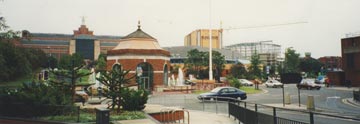 |
|
| home | 419 | architexts | avant gardening | counter culture | monomusic | over here over there | politricks | superimposed cities |
|
|
| home
||| superimposed city tours ||| research: leeds |||
||| leeds - quarry hill flats ||| Quarry Hill Flats stood on the eastern flank of the town centre. They were unfinished as the war began, though the first tenants had moved in during 1938. Building continued until 1941, by which time all 938 flats were completed. The estate was the largest European experiment in social housing in the 20th Century, although many public facilities intended for the estate were never completed. After the war, it was beset by structural and social problems, and it was demolished in 1978. My research into Quarry Hill has focused largely on the book 'Model Estate' by Alison Ravetz, and a number of general observations are quoted from this source. St. Patricks Church is mentioned in newspaper reports. It was situated across the road from the north-east corner of the estate. Thank you to Bernard Caine for correcting me on details about the church.  ||| Site of Quarry Hill Flats, 10/02 ||| In contrast to the dwellings, the community features of the Quarry Hill design did not get passed into general practice. War prevented their full completion and by the time it might have been possible to implement them the official concensus was that they had 'failed'. By this time the original plan for developing the whole inner ring of Leeds with Quarry Hill type estates was forgotten. Alison Ravetz, Model Estate, p.66 During the war, 37 of the flats had been shattered by a bomb dropped on the nearby railway and there had been one direct hit on the estate; but on both occasions damage to the structure of the buildings was negligible. Alison Ravetz, Model Estate, p.80 In the 15 months leading up to the outbreak of war many of the flats were vacant and the degree of movement in and out of the estate was high. But after 1939 the influx of Dunkirk survivors, war workers, evacuees and - towards the end of the war - displaced people from Europe, prevented all voluntary residential movement. Many of the newcomers stayed on after the war and became part of the permanent population of the estate. Alison Ravetz, Model Estate, p.89 During the war years underground air raid shelters had filled up many open spaces, and the recreation ground that was to have sported bowling greens and tennis courts was 'growing a fine crop of broken bottles, tin cans, soot, refuse and rubbish in general' [Yorkshire Observer, 20/09/9]. As soon as the war ended the tenants' committee began agitating for completion of the estate... Alison Ravetz, Model Estate, p.141
Quarry Hill Flats was damaged when a nearby goods yard was hit. A gas main was severed, and the fire burned so severely that the stained glass windows in St. Patricks church melted. Documentary film, Leeds At War
Coolness in raids on N.E. Towns Windows in [Quarry Hill] Flats Shattered: [St. Patricks] Church Damaged In an industrial area of a North East town bombs fractured a gas main early yesterday morning and started a fire which caused a brilliant blaze until it was quickly subdued. A modern inn nearby was severely damaged, and older premises on the opposite side of the road which it replaced were demolished and the ruins set on fire. A lock-up shop nearby was also hit and burnt out. In this raid one civilian was killed, and among other casualties was an air-raid warden who lost a leg. The fronts of a row of shops, with dwellings above, were blown out but only minor injuries were sustained by the occupants. Flying glass caused slight injuries when thousands of window-panes were shattered in a block of [Quarry Hill] flats in the vicinity. [St. Patricks] Roman Catholic church, school and presbytery suffered damage. A warehouse was also affected by blast and a cartage office in the yard completely wrecked. ... The local authority quickly found alternative accommodation for 14 families affected by the damage to the [Quarry Hill] flats and other rendered temporarily homeless. Yorkshire Post, 02/09/40 Heaviest Raids on Britain Night Bombing of North Store Set on Fire During the first attack - made just as the town's amusement places were emptying - a large store, a chapel, and a cinema were struck... Subsequently, bombs were dropped on industrial premises, [St. Patricks] church - which suffered a direct hit with high explosive... No one was injured at the [St. Patricks] presbytery or the nun's house adjoining a demolished Roman Catholic church. Yorkshire Evening Post, 02/09/40 |
|
|||||||||||||||||||
|
|||||||||||||||||||||